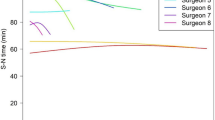Abstract
Study Objective
To evaluate the resident learning curve, demographic and comparative analysis of total laparoscopic hysterectomy.
Design
This retrospective observational study was conducted in a high-volume resident training setup.
Setting
Tertiary care center is used in the study.
Materials and Methods
Eight hundred and one total laparoscopic hysterectomy patients operated by the residents between July 2013 and June 2019 were evaluated with respect to the learning curve, duplication of the steps, the results in terms of intra- and postoperative complications and the time taken for the surgery. Surgeries were assigned as per the institutional inclusion criteria for the residents. The fellowship program enrolled six residents per year for training period of 1 year. The residents initially performed ten simple cases under the supervision of the director followed by ten cases which were performed independently, and based on their learning curve, they then performed advanced cases independently.
Results
TLH was successfully performed in all women by surgical residents in training. The surgical time was 61–120 min in majority (49.3%). 2.99% had intra-operative complications while 7.61% had postoperative complications which were identified and managed. All women recovered uneventfully.
Conclusion(s)
Dedicated teaching staff, uniform surgical protocols and high-volume centers contribute to the safety of TLH.




Similar content being viewed by others
Abbreviations
- TLH:
-
Total laparoscopic hysterectomy
- BMI:
-
Body mass index
- LSCS:
-
Lower segment cesarean section
- Fig:
-
Figure
- LH:
-
Laparoscopic hysterectomy
- LAVH:
-
Laparoscopic assisted vaginal hysterectomy
- CO2:
-
Carbon dioxide
- POD:
-
Postoperative day
- LSCH:
-
Laparoscopic-assisted supracervical hysterectomy
- N:
-
Number
- PID:
-
Pelvic inflammatory disease
References
Puntambekar S, Shetty TS, Goel A, et al. Single-centre experience of doing safe total laparoscopic hysterectomy: retrospective analysis of 1200 cases. J Obstet Gynecol India. 2020;70(5):376–83.
Kreuninger JA, Cohen SL, Meurs EAIM, Cox M, et al. Trends in readmission rate by route of hysterectomy—A single-centerexperience. Acta ObstetGynecolScand. 2018;97:285–93.
Pattanaik T, Mishra SP, Das S. Total laparoscopic hysterectomy–a retrospective observational study in a teaching hospital. Ann Int Med Den Res. 2017;3(1):OG10-13.
Wallenstein M, Ananth V, Kim J, et al. Effect of surgical volume on outcomes for laparoscopic hysterectomy for benign indications. Obstet Gynecol. 2012;119:709–16.
David-Montefiore E, Rouzier R, Chapron C, et al. Surgical routes and complications of hysterectomy for benign disorders: a prospective observational study in French university hospitals. Human Reprod. 2007;22(1):260–5.
Puntambekar SP, Wagh GN, Puntambekar SS, et al. A novel technique of total laparoscopic hysterectomy for routine use: evaluation of 140 cases. Int J Biomed Sci. 2008;4(1):38–43.
Sinha R, Sundaram M, Lakhotia S, et al. Total laparoscopic hysterectomy for large uterus. J Gynecol Endosc Surg. 2009;1(1):34–9.
Vree F, Cohen S, Chavan N, et al. The impact of surgeon volume on perioperative outcomes in hysterectomy. JSLS. 2014;18:174–81.
Mikhail E, Scott L, Miladinovic B, et al. Association between fellowship training, surgical volume, and laparoscopic suturing techniques among members of the American association of gynecologic laparoscopists. Minimally Invasive Surg. 2016;2016:1–6.
Nagar O, Sharma A, Shankar V, et al. A comparative study of total laparoscopic hysterectomy and non-descent vaginal hysterectomy for treatment of benign diseases of uterus. Int J Clin Obstetri Gynaecol. 2018;2(4):63–8.
Llarena N, Shah A, Milad M. Bowel injury in gynecologic laparoscopy: a systematic review. Obstetri Gynecol. 2015;125(6):1407–17.
Garry R, Fountain J, Mason S, et al. The eVALuate study: two paralel randomized trials, one comparing laparoscopic with abdominal hysterectomy, the other comparing laparoscopic with vaginal hysterectomy. BMJ. 2004;328:129.
Bettaiah R, Reddy C, Anantha R. Laparoscopic hysterectomies: our 10 years’ experience in a single laparoscopic center. J Obstetri Gynecol India. 2016;66(4):274–81.
Terzi H, Biler A, Demirtas O, et al. Total laparoscopic hysterectomy: analysis of the surgical learning curve in benign conditions. Int J Surg. 2016;35:51–7.
Wattiez A, Soriano D, Cohen SB, et al. The learning curve of total laparoscopic hysterectomy: comparative analysis of 1647 cases. Am Assoc Gynecol Laparosc. 2002;9(3):339–45.
Ascher-Walsh CJ, Capes T. An evaluation of the resident learning curve in performing laparoscopic supracervical hysterectomies as compared with patient outcome: Five-year experience. J Minimally Invasive Gynecol. 2007;14(6):719–23.
Twijnstra AJH, Blikkendaal MD, Kolkman W, Smeets MJGH, et al. Implementation of laparoscopic hysterectomy: maintenance of skills after a mentorship program. Gynecol Obstet Invest. 2010;70:173–8.
Smith K, Caceres A. Vaginal cuff closure in minimally invasive hysterectomy: a review of training, techniques, and materials. Cureus. 2017;9(10):e1766. https://doi.org/10.7759/cureus.1766.
Author information
Authors and Affiliations
Corresponding author
Ethics declarations
Conflict of interest
The authors declare that they have no conflicts of interest and nothing to disclose.
Ethical Approval
The study was approved by the Institutional Ethics Committee. Institutional Ethical Clearance taken.
Informed Consent
Informed consent was obtained from all human participants.
Additional information
Publisher's Note
Springer Nature remains neutral with regard to jurisdictional claims in published maps and institutional affiliations.
Shailesh Puntambekar, Specialist in the Department of Minimal Access Surgery; Theertha Shetty, Fellow in the Department of Minimal Access Surgery (Gynaecology); Seema Puntambekar, Specialist in the Department of Minimal Access Surgery; Arjun Goel, Fellow in the Department of Minimal Access Surgery; Mangesh Panse, Specialist in the Department of Minimal Access Surgery; Ravindra Sathe, Specialist in the Department of Minimal Access Surgery; Swapnil Shelke, Fellow in the Department of Minimal Access Surgery (Gynaecology).
Rights and permissions
About this article
Cite this article
Puntambekar, S., Shetty, T., Puntambekar, S. et al. Learning Curve of Total Laparoscopic Hysterectomy for a Resident in a High-Volume Resident Training Setup. J Obstet Gynecol India 72 (Suppl 1), 267–273 (2022). https://doi.org/10.1007/s13224-021-01540-8
Received:
Accepted:
Published:
Issue Date:
DOI: https://doi.org/10.1007/s13224-021-01540-8




